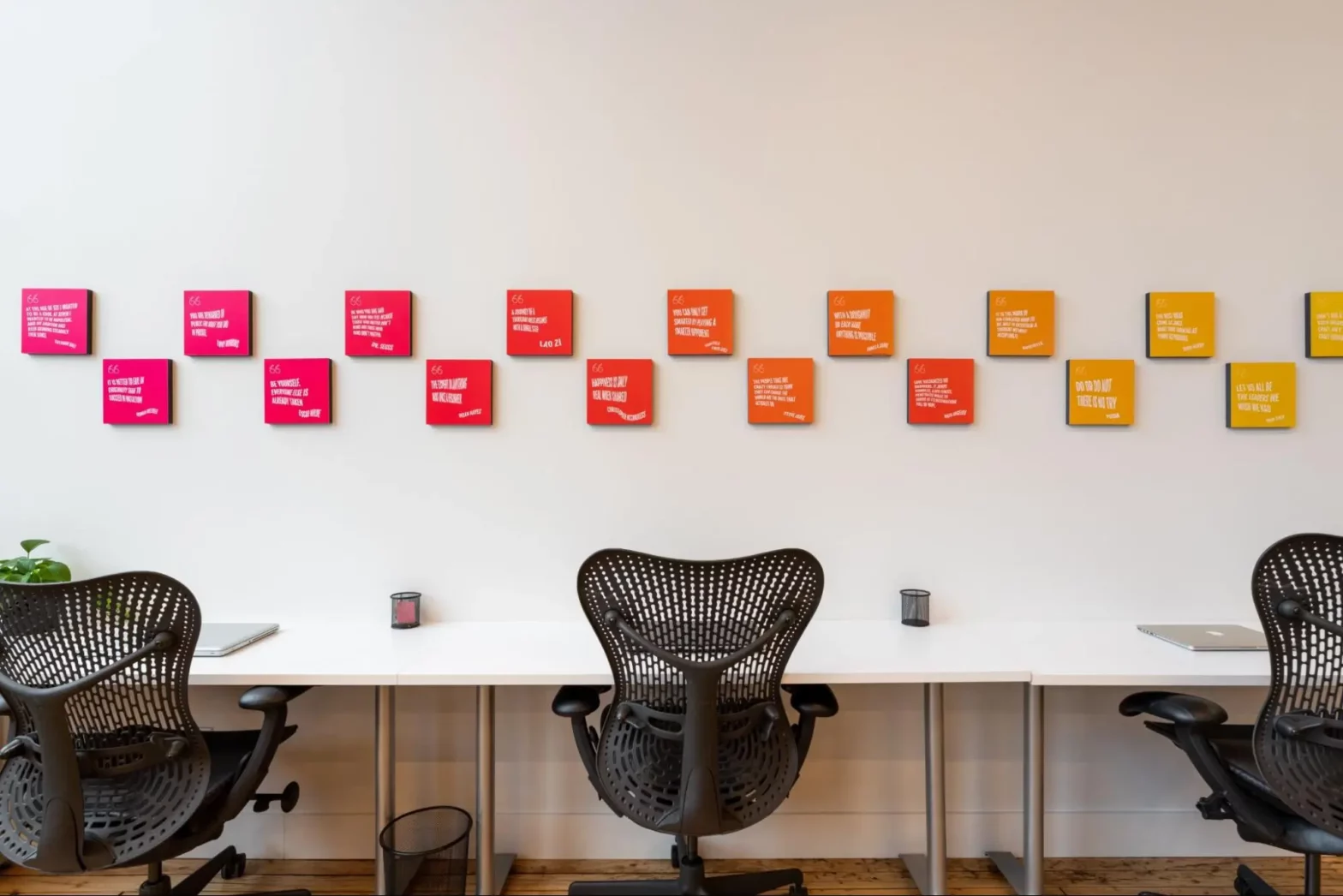
Why Do Employees Quit and How Can You Prevent It?
Broken trust between managers and employees is one of the major reasons why employees quit. To enhance employee retention, employers and managers must foster trust through transparent communication, fair compensation, opportunities for growth, and inclusive recruitment practices.
Employees leave when they stop trusting their workplaces. Whether due to poor leadership, unmet expectations, or burnout, this erosion of trust brings down morale. Eventually, it breaks down the team.
We’re seeing it now more than ever:
- Employees’ trust in immediate managers fell from 46% to 29% between 2022 and 2024.
- Only 60% of employees feel genuinely trusted, despite 86% of executives believing they show strong trust in their staff.
- One in two employees in the U.S. is considering a job change, while voluntary turnover has reached nearly 12% in Canada.
This growing trust gap and workforce instability are creating real problems, especially for employers and human resource managers. At Ad Culture, we see these issues firsthand. More companies come to us with hard-to-fill roles in marketing, not because talent doesn’t exist, but because they’re more selective than ever.
In this article, we’ll explore the main reasons why employees quit, how you can spot the signs, and the most effective strategies you can use to retain your best people. Let’s get started!
| Why Employees Quit and How to Cultivate Good Rapport |
Why Is Employee Retention Important?
Employee retention has a direct impact on overall productivity, culture, and profits. A company with high retention rates typically enjoys:
- Stronger company culture
- Higher employee engagement
- Better customer experience and satisfaction
- Higher profits
- More innovation and ideas
- More positive employer reputation
- Better performance and long-term growth
What Makes an Employee Want to Quit?
Employees quit when they feel undervalued, unsupported, or misled. These feelings often stem from:
Rigid Return-to-Office Policies
Since the pandemic, flexibility has been one of the major drivers of employee satisfaction. Across industries, workers consistently report that they value flexible work arrangements more highly than higher pay or promotions. Yet many employers remain hesitant to fully implement remote or hybrid models.
Instead, they’re doubling down on return-to-office (RTO) mandates. In 2025 alone, major companies such as Amazon, JPMorgan Chase, and Walmart have called employees back on-site, with some returning as often as four to five days a week.
As you can expect, employees aren’t happy.
- 48% of RTO employees feel like they’re just showing up to be seen
- 26% report feeling unsupported
- Nearly two in five say they’re less productive due to socializing + unnecessary distractions
- More than a quarter of employees would consider quitting if their company enacted RTO policies
All in all, it’s not a good look for employee engagement and retention. What’s worse, RTO mandates appear to be related to workforce downsizing or quiet cutting. Not only does this undermine employee sentiment, but it also spells trouble for employer branding and trust.
| ✅ Solution: Offer Flexibility with Structure |
Instead of enforcing rigid RTO policies, offer flexible work models that match your employees’ needs and expectations. If you genuinely feel that in-office presence is necessary, clearly explain why. Tie it to team goals, client needs, or key moments for collaboration.
What Is Quiet Cutting? |
| Quiet cutting (also known as silent cutting or quiet firing) is when employers push employees to quit instead of firing them. It can be achieved through overt strategies, such as going for RTO mandates, or subtle ones, like role reassignments or delayed promotions. |

Image Source: Shutterstock
Inadequate Salary & Benefits
One of the primary reasons employees quit is when compensation and benefits are inadequate. But it’s often less about the dollar amount and more about transparency and fairness. In most cases, employee morale and loyalty suffer when:
- Employees don’t understand how compensation decisions are made
- Pay is inconsistent across similar roles
- Employee benefits packages don’t match employee needs or industry standards
- Extra responsibilities aren’t fairly compensated
- Raises and promotions are delayed or unclear
- There’s no employee recognition for achievements and accomplishments
Some pay variation is normal in any organization. When pay differences reflect meaningful distinctions like skills, experience, or responsibilities, they may even increase trust. The employee turnover problem arises when these pay differences appear arbitrary or unfair, such as in cases of gender wage gaps or unexplained inconsistencies.
What are the employee retention strategies that can help? |
To boost employee retention rate, employers must offer both competitive compensation and a transparent, growth-focused company culture. To motivate employees and increase employee satisfaction, focus on providing:
|
Related Resource: An Employer’s Guide to Benefits for Employees in Canada
Lack of Career Development Opportunities
Top talent doesn’t just work to get paid. They work to grow, be challenged, and stay ahead.
Marketers and advertisers are especially growth-driven because they recognize that the industry evolves rapidly. If they’re not constantly learning new tools, platforms, and trends, they’re falling behind, and they know it.
That’s why a lack of professional growth remains one of the major reasons why employees quit. Roughly one in three Millennials and Gen Z employees would leave a job without professional development opportunities. Even older employees (over 40 and 50) largely prefer jobs with strong career development programs.
Unfortunately, many employers still see growth as optional—or worse, a threat. Some think, “What if we pay for courses and they leave?” What if employees use that knowledge for a competitor?
While those are valid concerns, the reality is that most employees want to upskill so they can do better in their current roles. Besides, the bigger risk isn’t that they’ll leave after learning—it’s that they’ll stay without growing.
Imagine your SEO Manager is still stuck on outdated keyword strategies when AI has changed the search landscape. When you support employees’ growth, you’re investing in their skills, loyalty, and trust—all of which they’ll invest right back.
| ✅ Solution: Personalized Development Plans |
Part of the reason why many professional development programs don’t help retain employees is that they lack relevance. Effective employee retention strategies consider each employee’s goals, learning styles, and career aspirations. Encourage employees to co-create their development plans with their managers and figure out what works best for them.
How does career development affect employee performance? |
| When people grow, performance grows with them. Investing in career development helps build employee engagement, confidence, and motivation. They’re more likely to take initiative, develop new skills, and contribute at a higher level. |
Related Resource: The Impact of Feedback on Employee Development

Image Source: Shutterstock
Toxic Leadership
People don’t quit companies, they quit bad managers. Stats actually back this statement up:
- 50% of Americans self-report having at some point left a job specifically to escape their boss
- Nearly 75% of employees have worked for a toxic workplace
- Of those, 78.7% blame poor leadership as the root cause of toxicity
Toxic leadership is the fastest way to ruin employee trust and increase turnover. It comes in many forms, including micromanagement, favouritism, poor communication, lack of empathy, or taking credit for others’ work.
When leadership is toxic, it infects company culture. Culture then wears teams down, leading to uncertainty, stress, disengagement, and poor employee job satisfaction. Productivity, morale, and trust suffer as a result.
Even your highest-performing team members won’t thrive in such an environment. They’ll eventually walk, leaving you to rehire, retrain, and repair team dynamics.
| ✅ Solution: Coach and Hold Leaders Accountable |
Toxic leadership is often a systemic issue; therefore, the best solution begins at the top.
- Train leaders to manage with empathy, fairness, and clarity.
- Create robust internal communication channels to encourage employees to voice concerns safely.
- Provide coaching on emotional intelligence, communication, and team development.
- Implement 360-degree reviews so staff can provide employee feedback on their managers.
- Hold leaders accountable when problems arise.
Related Resource: Guide to Improving Employee Experience
What are the top signs of employee dissatisfaction |
|
Unclear Expectations + Overpromising in Hiring
The hiring process is a two-way trust exercise. You’re trusting candidates to bring the right skills, attitude, and work ethic. They’re trusting your promises about the role, the culture, and the career advancement opportunities.
One of the main reasons why employees quit is a mismatch between what they were told during the interview and what they experience at work. If you oversell the role during the onboarding process or don’t deliver on expectations, you’re setting the tone for poor employee retention.
| ✅ Solution: Be Honest and Consistent from Day One |
To reduce turnover, ensure your employee experience matches the narrative you’re selling during recruitment. Be honest and realistic so your new employees don’t feel misled.
Related Resource: How to Create an Effective Employee Onboarding Process
Burnout
Another major obstacle to retaining top talent is burnout, a problem which has escalated sharply since the pandemic. Today, roughly two-thirds of workers experience job burnout, with Millennials and Gen Z at a higher risk.
This isn’t just because of one or two stressors. Over the past few years, the workforce has jumped from crisis to crisis:
- The 2020 pandemic upended routines and blurred work-life boundaries
- The Great Resignation of 2021 led to staff shortages and heavier workloads
- Mass job cuts and sluggish hiring from 2022 to 2024 left remaining teams stretched thin
- Rising inflation, economic instability, and global conflicts added financial and emotional strain
- AI disruption sparked fears around job security and the pressure to constantly reskill
All these have led to a workforce that’s running on fumes. Employees are exhausted, anxious, and mentally drained. When this happens, work-life balance suffers, and resignations often follow.
If employers push through without adjusting expectations, workloads, or support systems, you risk losing your most valuable people.
| ✅ Solution: Prioritize Sustainable Workloads and Mental Health |
- Encourage a healthy work-life balance by fostering a culture that promotes overall well-being.
- Set realistic workloads and clear boundaries around after-hours communication.
- Normalize taking time off—and model it at the leadership level.
- Provide wellness offerings and mental health resources.
- Encourage regular check-ins.
- Create space for employees to voice concerns before they hit a breaking point.
Related Resource: Retaining Generation Z: Creating a Future-Ready Workplace
What are the signs that an employee is experiencing burnout? |
|
| Behavioral Signs | Physical & Emotional Signs |
|
|
DEI Stagnation
Diversity, equity, and inclusion (DEI) have a real and lasting impact on employee retention, largely due to their influence on culture and psychological safety. Companies with strong, ongoing DEI efforts see higher employee engagement, stronger team collaboration, and better retention—especially among underrepresented groups.
However, recent years have been rough for DEI efforts. Legal pressure, political backlash, or budget cuts are forcing organizations to scale back or “quietly shelve” DEI initiatives. The effects of this “backward” momentum risks:
- Worsening talent crisis (especially in tech)
- Underrepresented employees feeling less supported and more isolated
- Psychological safety eroding across teams
- Declining trust in leadership
- Employer branding and reputation nosediving among job seekers and clients
- Dropping retention rates, especially for women and minorities
| ✅ Solution: Recommit to DEI with Clarity and Consistency |
Even in the face of legal or political headwinds, DEI remains a key driver of retention, innovation, and trust. Focus your efforts on sustained, visible actions like:
- Inclusive hybrid work arrangements
- Skills-first hiring and promotion strategies
- Robust mentorship programs
- Ongoing, practical DEI training
- Equitable compensation and benefits
- Transparent communication and accountability
Quick Recap
- Broken trust is a significant factor in why employees leave. This erosion of trust stems from issues like:
- Rigid return-to-office mandates
- Inadequate pay and benefits
- Lack of career growth
- Toxic leadership
- Unclear hiring expectations
- Widespread burnout
- Stagnant DEI efforts.
- To boost retention, employers must proactively address each pain point and foster a culture of trust, flexibility, growth, and accountability.
- Effective employee retention strategies include:
- Offering flexible work models with a clear structure
- Providing competitive, transparent compensation
- Personalizing career development plans
- Training and holding leaders accountable
- Setting honest expectations during hiring
- Supporting employee mental health and wellbeing
- Recommitting to practical, sustained DEI efforts
- Fostering strong internal communication and transparency
What’s Killing Your Retention?
There are many reasons why employees quit, but nearly all are preventable. At Ad Culture, we know the most effective retention strategy starts with the right team.
When you bring people who truly fit, you’re already halfway to building a culture they’ll want to stay and grow in. That’s why we help businesses like yours find and keep marketing unicorns through our:
- Bias-free hiring process
- Culture-first matching system
- Retention-ready onboarding
No matter where your retention challenges lie, we can help you fill the gaps. Share your biggest retention challenges with Ad Culture to find out how we can help you build a workplace people want to grow.








